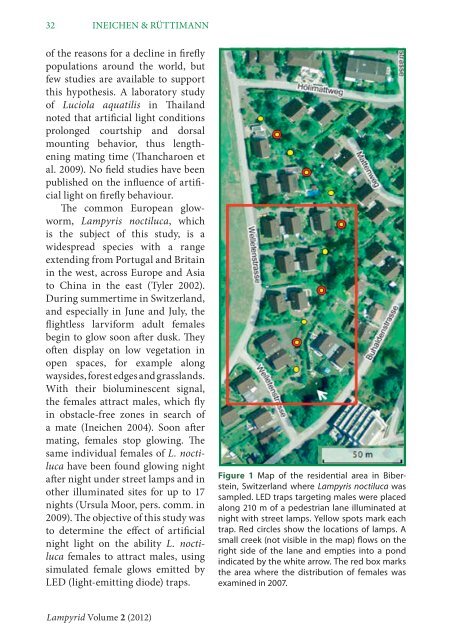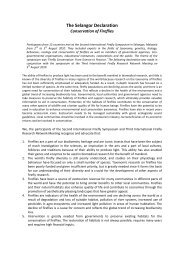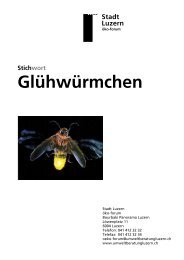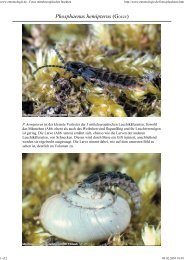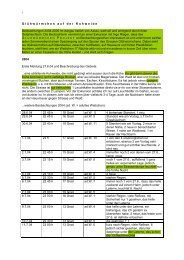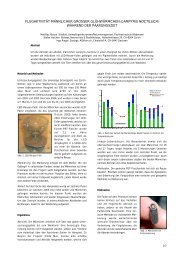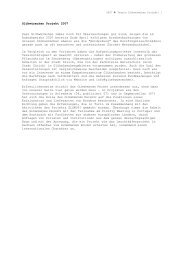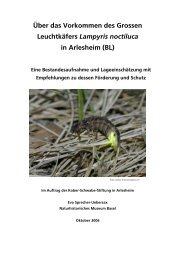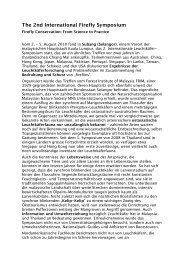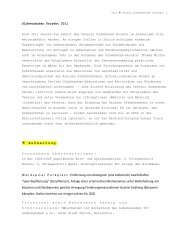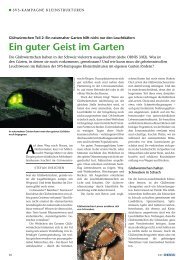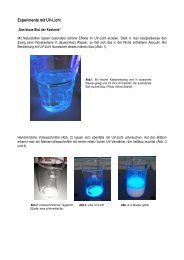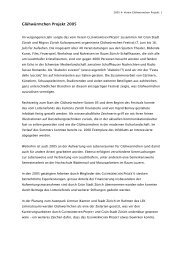Impact of artificial light on the distribution of the ... - Glühwürmchen
Impact of artificial light on the distribution of the ... - Glühwürmchen
Impact of artificial light on the distribution of the ... - Glühwürmchen
Create successful ePaper yourself
Turn your PDF publications into a flip-book with our unique Google optimized e-Paper software.
32 Ineichen & Rüttimann<br />
<str<strong>on</strong>g>of</str<strong>on</strong>g> <strong>the</strong> reas<strong>on</strong>s for a decline in firefly<br />
populati<strong>on</strong>s around <strong>the</strong> world, but<br />
few studies are available to support<br />
this hypo<strong>the</strong>sis. A laboratory study<br />
<str<strong>on</strong>g>of</str<strong>on</strong>g> Luciola aquatilis in Thailand<br />
noted that <str<strong>on</strong>g>artificial</str<strong>on</strong>g> <str<strong>on</strong>g>light</str<strong>on</strong>g> c<strong>on</strong>diti<strong>on</strong>s<br />
prol<strong>on</strong>ged courtship and dorsal<br />
mounting behavior, thus leng<strong>the</strong>ning<br />
mating time (Thancharoen et<br />
al. 2009). No field studies have been<br />
published <strong>on</strong> <strong>the</strong> influence <str<strong>on</strong>g>of</str<strong>on</strong>g> <str<strong>on</strong>g>artificial</str<strong>on</strong>g><br />
<str<strong>on</strong>g>light</str<strong>on</strong>g> <strong>on</strong> firefly behaviour.<br />
The comm<strong>on</strong> European glowworm,<br />
Lampyris noctiluca, which<br />
is <strong>the</strong> subject <str<strong>on</strong>g>of</str<strong>on</strong>g> this study, is a<br />
widespread species with a range<br />
extending from Portugal and Britain<br />
in <strong>the</strong> west, across Europe and Asia<br />
to China in <strong>the</strong> east (Tyler 2002).<br />
During summertime in Switzerland,<br />
and especially in June and July, <strong>the</strong><br />
f<str<strong>on</strong>g>light</str<strong>on</strong>g>less larviform adult females<br />
begin to glow so<strong>on</strong> after dusk. They<br />
<str<strong>on</strong>g>of</str<strong>on</strong>g>ten display <strong>on</strong> low vegetati<strong>on</strong> in<br />
open spaces, for example al<strong>on</strong>g<br />
waysides, forest edges and grasslands.<br />
With <strong>the</strong>ir bioluminescent signal,<br />
<strong>the</strong> females attract males, which fly<br />
in obstacle-free z<strong>on</strong>es in search <str<strong>on</strong>g>of</str<strong>on</strong>g><br />
a mate (Ineichen 2004). So<strong>on</strong> after<br />
mating, females stop glowing. The<br />
same individual females <str<strong>on</strong>g>of</str<strong>on</strong>g> L. noctiluca<br />
have been found glowing night<br />
after night under street lamps and in<br />
o<strong>the</strong>r illuminated sites for up to 17<br />
nights (Ursula Moor, pers. comm. in<br />
2009). The objective <str<strong>on</strong>g>of</str<strong>on</strong>g> this study was<br />
to determine <strong>the</strong> effect <str<strong>on</strong>g>of</str<strong>on</strong>g> <str<strong>on</strong>g>artificial</str<strong>on</strong>g><br />
night <str<strong>on</strong>g>light</str<strong>on</strong>g> <strong>on</strong> <strong>the</strong> ability L. noctiluca<br />
females to attract males, using<br />
simulated female glows emitted by<br />
LED (<str<strong>on</strong>g>light</str<strong>on</strong>g>-emitting diode) traps.<br />
Figure 1 Map <str<strong>on</strong>g>of</str<strong>on</strong>g> <strong>the</strong> residential area in Biberstein,<br />
Switzerland where Lampyris noctiluca was<br />
sampled. LED traps targeting males were placed<br />
al<strong>on</strong>g 210 m <str<strong>on</strong>g>of</str<strong>on</strong>g> a pedestrian lane illuminated at<br />
night with street lamps. Yellow spots mark each<br />
trap. Red circles show <strong>the</strong> locati<strong>on</strong>s <str<strong>on</strong>g>of</str<strong>on</strong>g> lamps. A<br />
small creek (not visible in <strong>the</strong> map) flows <strong>on</strong> <strong>the</strong><br />
right side <str<strong>on</strong>g>of</str<strong>on</strong>g> <strong>the</strong> lane and empties into a p<strong>on</strong>d<br />
indicated by <strong>the</strong> white arrow. The red box marks<br />
<strong>the</strong> area where <strong>the</strong> distributi<strong>on</strong> <str<strong>on</strong>g>of</str<strong>on</strong>g> females was<br />
examined in 2007.<br />
Lampyrid Volume 2 (2012)


